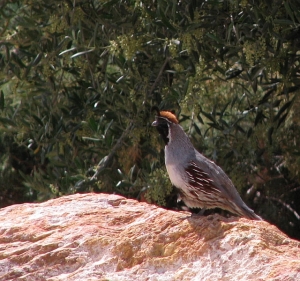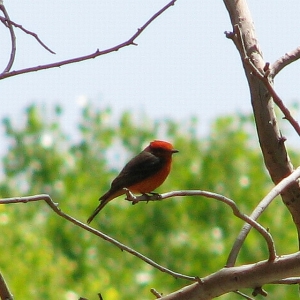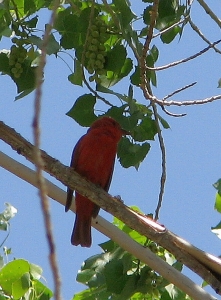Free email delivery
Please sign up for email delivery in the subscription area to the right.
No salesman will call, at least not from us. Maybe from someone else.
Tropical Treats with Femi | Pajaros Y Comidas de Colombia
[Posted by Chuck Almdale]
Femi Faminu returns to Colombia, this time staying at Aracuana Lodge in the Cauca Valley, near Cali and southwest of the capital of Bogotá, an area stuffed to the gills with birds. Indeed, the first bird in the film is a hoot-honking (and perhaps duetting) Toucan Barbet, one of only two members in its family Semnornithidae, one of the seven families of Piciformes (Woodpeckers & their pals). Eventually the food appears, and I believe I saw one version of the ubiquitous South American dessert pass by, known to its aficionados as fluffy white stuff.
It’s good to know that Colombia is again safe enough to travel in. When bird field guides for Central and South America began to appear decades ago, permitting travel by birders who were not fully-employed professional ornithologists on collecting trips, one of the first books to appear was one for Colombia. By the time a second, improved guide was published, the various Colombian insurgent groups had appeared, and birders completely avoided Colombia, going instead to nearby Panama, Ecuador and Venezuela, as well as points south, and that field guide languished. Birders have been again visiting Colombia for the past decade or so, and there are several excellent in-country birding tour companies, plus many international birding tour companies visiting regularly.
According to WorldRainForests Colombia now has the highest bird species count in the world: 1,917 species (18.3% of world species), followed closely by Peru at 1,892, Brazil 1,864, Indonesia 1,791 and Ecuador 1,684. Brazil led for a long time, but in recent decades Peru consistently was first. Colombia, most likely, recently took the lead because – safety now restored – researchers (not to mention garden-variety birders like us) could again explore the mountains and rainforests and discover new species.
At the end of the video is her phylogenetically-sequenced trip lists which includes 241 species, 108 non-passerines and 133 passerines. Twenty-six hummers, twenty-six Tyrant Flycatchers, twenty-four Tanagers anyone? Her all-too-brief YouTube photo & video film is as enjoyable as always, despite the notable absence of one of my favorite birds, the startlingly-plumaged Oleaginous Pipromorpha.
If you go here https://www.youtube.com/@femif9792 you can see her other films.
If you’re interested in this trip, we suggest you get your motel reservation (or Joshua Tree National Park campsite) as soon as possible. Rooms do fill up this time of year.
Only 5 shopping days remain! If you’re coming, let the leader know so she can expect you. The leaders will be staying Saturday night at the Best Western Motel (Sure Stay Plus) in Yucca Valley (56525 29 Palms Highway, Yucca Valley, California 92284-2863; 760-365-3555) or national Best Western 800-780-2734. The Super 8 is a bit cheaper and not far away.
Nearby Yucca Valley has several motels and Joshua Tree National Monument has several campgrounds. Campsites at Mission Creek Preserve, several miles south of Morongo Valley, must be reserved at least a week in advance. (60550 Mission Creek Road, Desert Hot Springs, CA. 760-369-7105)
Joshua Tree National Park Camping
Black Rock Campground: LINK 877-444-6777, www.recreation.gov
— We bird at Black Rock on Sat. afternoon; 16 miles from Morongo Valley Reserve.
Indian Cove Campground: LINK 877-444-6777, www.recreation.gov
— Between Joshua Tree town and 29 Palms; 29 miles from Morongo Valley Reserve.
Our long-term go-to restaurant (La Casita) closed and we haven’t yet figured out where to eat dinner Saturday night. Someplace that serves beer (desert birding can be hot work!). Call Jean if you have a recommendation.
Map of motels in Yucca Valley, the nearest town to Morongo Valley: [prices are from Google map. They may be wildly inaccurate but also may reflect typical price difference between motels.] America’s Best Value Inn ($94), Bungalows Homestead ($304), Super 8 Wyndham ($84), Sure Stay Plus Best Western ($127). Map also shows motels for Desert Hot Springs (17), Joshua Tree (4), 29 Palms (9).

(taken before the June, 2005 fire)
Big Morongo Canyon Preserve is one of the finest birding spots in southern California. It is best-known as a springtime migrant trap, frequently catching rare eastern migrants, hummers and orioles at the feeders, but also has regular local specialties such as Vermilion Flycatcher, Brown-crested Flycatcher, Summer Tanager and Yellow-breasted Chat. On a busy day, the trees and bushes are filled with migrating birds, especially warblers. Many local desert species are also seen such as Gambel’s Quail, Costa’s Hummingbird and Verdin. Reserve hours are 8:00 a.m.-sunset.

Saturday, 3pm – Black Rock Campground near Yucca Valley: For those staying overnight Saturday, we meet at the Campground Visitor Center and bird in and near the campground, looking for Gambel’s Quail, White-winged Dove, Roadrunner, Ladder-backed Woodpecker, Pinyon Jay, Verdin, Scott’s Oriole and whatever else is around. If you’re late, just drive around until you spot some birders. The campground is nearly always fully occupied Saturday night. Know how to get there as local signs are not well marked. Allow at least 2.5 hours – better yet, three hours, for the 140-mile trip from Santa Monica.
Google Map to Black Rock Campground
Brief Directions: I-10 or I-10/I-60/I-10 for about 2 hours to Exit 117, Hwy 62 North. [Do NOT go south to Palm Springs on Hwy 111.] North on #62 (Twenty-Nine Palms Hwy) about 30 minutes through small Yucca Valley business area to intersection with Old Woman Springs Rd (#247) to left / Joshua Lane to right, and turn RIGHT (south) onto Joshua Lane. Follow signs about 5 miles to Black Rock Campground (unit of Joshua Tree Nat. Park). Meet at campground HQ. If you’re late, drive around the campground and South Park Rd. (to NW past the ranger buildings – see map closeup) until you find us.
Leader: Jean Garrett (213-522-0062) Please call Jean if you are going. It helps to know whom to expect.

(L. Johnson 5/3/08)
Sunday, 7:30 am – Big Morongo Canyon Preserve: We officially start at 8am in the Preserve’s parking lot. If you arrive early, birding at Covington Park just south of the Preserve is also great. Some neighbors put out feeders and water, especially the corner house across from Covington Park and the house just past that, so a short stroll is a good idea. After the preserve opens, we’ll walk around the large reserve until we’re too hot, tired, thirsty, hungry or all of the above to continue, then have lunch. Allow a minimum of 2 1/4 hours for the 125-mile trip from Santa Monica. Special birds of the area are Brown-crested Flycatcher, Vermilion Flycatcher and Summer Tanager, plus Yellow-breasted Chat, MacGillivray’s Warbler and most of the local desert birds, plus whatever migrant passerines happen to be arriving or stayed overnight. It can be very birdy, but it’s the luck of the draw and the local winds.
Google Map to Morongo Reserve
Brief Directions: I-10 or I-10/I-60/I-10 for about 2 hours to Exit 117, Hwy 62 North. [Do NOT go south to Palm Springs on Hwy 111.] North on #62 (Twenty-Nine Palms Hwy) about 11.5 miles into Morongo Valley and passing partway through small Morongo Valley town. Angle right onto Park Ave. Turn left on Vale St., passing Covington Park on your right, then bear right through several turns until you reach Covington Dr., the entrance to the preserve. If the preserve is not yet open (7:30am), retrace your path back to Covington Park where the birding is great. [Chuck Almdale]
Leaders: Jean Garrett (213)-522-0062
Family Guide: Can get quite hot; not for younger children. 1-2 miles of boardwalk, cinder and hard dirt paths. Dress in layers & hat. Bring water. Lunch near the cars.
[Chuck Almdale]

Malibu Lagoon Monthly Field Trip: Sunday, 28 April 2024
[Posted by Chuck Almdale]

(L. Loeher Malibu Lagoon 04-19-19)
It’s ALWAYS the 4th (not the last!) Sunday of the month.
Same as last month: No reservations, no Covid card checks, no fuss, no muss.
Rules for Malibu Lagoon trip
- Masks not required; feel free to wear one whenever you want.
- Bring your own binoculars & telescope if you have them.
- We do have loaner binos but they don’t always show up in time to hand out.
- Participation in social activities, such as field trips, comes with an inherent risk of exposure to infectious disease. Prospective participants should self-evaluate or discuss with their doctor if their participation merits this risk. If you’re sick or experiencing any symptoms that indicate you might be sick, STAY HOME.
- The 10am Children & Parents Walk is reinstated. Call Jean Garrett (213)-522-0062
- For general questions contact Chuck: misclists[AT]verizon.net

Weather: Pleasant. Temp: 55-65°, Wind: ENE 6 mph, Clouds: 17%>10%, rain: 0%
Tide: Very low & rising: Low: -0.14 ft.@7 :38am; High: +2.69 ft.@ 3:02pm
Some of the wintering birds have left, but many remain, and our breeding birds are arriving. The air may be filled with swallows. There may be grebes, loons, pelicans, ducks, egrets, hawks, shorebirds, flycatchers, orioles, finches, ad infinitum.
Still more birds than you can shake a stick at:
Brant, Clark’s Grebe, Osprey, American Kestrel, Virginia Rail, Sora, Snowy Plover, Greater Yellowlegs, Black Turnstone, Surfbird, Dunlin, Bonaparte’s Gull, Royal, Elegant & Forster’s Terns, Eurasian Collared & White-winged Doves, Tree & Violet-Green Swallows, American Pipit, Cedar Waxwing, Orange-crowned & Wilson’s Warblers, Lazuli Bunting and Lesser Goldfinch.
If you arrive early you may perchance to espy a congregacon of plouerys.
Adult Walk 8:30 a.m., 4th Sunday of every month. Beginner and experienced, 2-3 hours. Species range from 35 in June to 60-75 during migrations and winter. We move slowly and check everything as we move along. When lagoon outlet is closed we may continue east around the lagoon to Adamson House. We put out special effort to make our monthly Malibu Lagoon walks attractive to first-time and beginning birdwatchers. So please, if you are at all worried about coming on a trip and embarrassing yourself because of all the experts, we remember our first trips too. Someone showed us the birds; now it’s our turn. Bring your birding questions.
Children and Parents Walk, 10:00 a.m., 4th Sunday of every month: One hour session, meeting at the metal-shaded viewing area between parking lot and channel. We start at 10:00 for a shorter walk and to allow time for families to get it together on a sleepy Sunday morning. Our leaders are experienced with kids so please bring them to the beach! We have an ample supply of binoculars that children can use without striking terror into their parents. We want to see families enjoying nature. (If you have a Scout Troop or other group of more than seven people, you must call Jean (213-522-0062) to make sure we have enough binoculars, docents and sand.)

Directions: Malibu Lagoon is at the intersection of Pacific Coast Highway (PCH) and Cross Creek Road, west of Malibu Pier and the bridge, 15 miles west of Santa Monica via PCH. We gather in the metal-shaded area near the parking lot. Look around for people wearing binoculars. Neither Google Maps nor the State Park website supply a street address for the parking lot. The address they DO supply is for Adamson House which is just east of the Malibu Creek bridge.
Parking: Parking machine installed in the lagoon lot: 1 hr $3; 2 hrs $6; 3 hrs $9, all day $12 ($11 seniors); credit cards accepted. Annual passes accepted. You may also park (read signs carefully) on either of PCH west of Cross Creek Road, on Cross Creek Road, or on Civic Center Way north (inland) of the shopping center. Lagoon parking in shopping center lots is not permitted (i.e. they tow cars).
Link to last year’s trip report: April 23 2023.
Prior checklists:
2023: Jan-June, July-Dec
2021: Jan-July, July-Dec 2022: Jan-June, July-Dec
2020: Jan-July, July-Dec 2019: Jan-June, July-Dec
2018: Jan-June, July-Dec 2017: Jan-June, July-Dec
2016: Jan-June, July-Dec 2015: Jan-May, July-Dec
2014: Jan-July, July-Dec 2013: Jan-June, July-Dec
2012: Jan-June, July-Dec 2011: Jan-June, July-Dec
2010: Jan-June, July-Dec 2009: Jan-June, July-Dec
[Written & posted by Chuck Almdale]
Red and Lilac-crowned Parrots in SoCal, with Brenda Ramirez: Zoom Evening Meeting, Tuesday, 7 May, 7:30 p.m.
You are all invited to the next ZOOM meeting
of Santa Monica Bay Audubon Society

|
Red and Lilac-crowned Parrots in SoCal, with Brenda Ramirez
Zoom Evening Meeting, Tuesday, 7 May, 7:30 p.m.
Zoom waiting room opens 7:15 p.m.
Non-native parrots have become a very present and boisterous element of the urban ecosystems throughout Southern California. Ranging from cities to more natural areas, parrots can be found in a variety of habitats where they coexist with people. Through the Free-Flying Los Angeles Parrot Project (FLAPP) on iNaturalist, we created a dataset focused on two of the more prominent species in Southern California, the Red-crowned and Lilac-crowned Parrots. After being introduced through the illegal pet trade, these sister-species have established their populations and even created mixed-species flocks that would not be possible otherwise. Originally from opposite coasts of Mexico, these parrots are model organisms for answering questions on range shifts and hybridization because of the unique displacement that has led to their coexistence. Our research has focused on distinguishing the two species based on morphological features, comparing the environmental conditions between their respective native ranges and their introduced range, and we are now shifting to understanding how their genetic makeup has been affected. Join us to learn how you can help contribute to our research from your own neighborhoods!

Brenda Ramirez has experience working with large citizen science datasets and incorporating them into spatial models to understand species distributions over thousands of years. Having recently graduated with her master’s degree from Cal Poly Pomona, Brenda is now working on Moore Lab’s Free-flying Los Angeles Parrot Project (FLAPP) to evaluate how the non-native Los Angeles parrot populations have changed genetically as they have adapted to their new urban habitats.

|
(If this button isn’t working for you, see detailed zoom invitation below.)
Meeting ID: 836 6737 7323
Passcode: 263461
One tap mobile
+16699009128,,83667377323#,,,,263461# US (San Jose)
+16694449171,,83667377323#,,,,263461# US
Dial by your location
+1 669 900 9128 US (San Jose)
+1 669 444 9171 US
+1 253 215 8782 US (Tacoma)
+1 346 248 7799 US (Houston)
+1 719 359 4580 US
+1 253 205 0468 US
+1 646 931 3860 US
+1 689 278 1000 US
+1 301 715 8592 US (Washington DC)
+1 305 224 1968 US
+1 309 205 3325 US
+1 312 626 6799 US (Chicago)
+1 360 209 5623 US
+1 386 347 5053 US
+1 507 473 4847 US
+1 564 217 2000 US
+1 646 558 8656 US (New York)
Meeting ID: 836 6737 7323
Passcode: 263461
Number: https://us02web.zoom.us/u/kdeqYfPIVa
King Gillette Field Trip reminder, Sat. 20 Apr 2024, 8am
[Posted by Chuck Almdale]

Saturday, 20 April. King Gillette Ranch. This 588-acre area was previously owned by razor magnate King Gillette, then by Soka University. While exploring both the developed creeks, lawns, groves and ponds, as well as undeveloped chaparral and riparian habitats, we’ll be looking for birds resident in these habitats such as California Thrasher, as well as any early migrants and wintering birds such as Lewis’ Woodpecker, which have been reported in the area. Oddities can turn up, such as the Northern Parula last New Year’s Day.
Family Guide: 1-2 miles of easy walking, roads, paths and lawn on mostly level ground.

[26800 Mulholland Hwy, Calabasas, CA 91302] From the intersection of Las Virgenes (Malibu Canyon) Rd. & Mulholland Hwy., east on Mulholland to the 1st right, past the park gate to the 1st right towards the Botanic Center (Native Plants Garden) where we meet. Here there are bathrooms, a drinking fountain, nature center and picnic tables should you choose to bring lunch. Free parking here, I believe. If you drive across the short bridge, parking is not free. Allow 45 minutes travel time from Santa Monica.
Meet at 8:00 am Leader: Chuck Bragg (310-454-9662)



